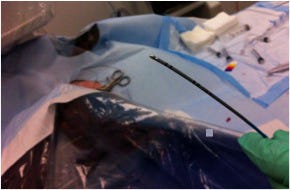How a New Coating Could Enable Tinier Electronics in the Body
January 21, 2015
|
An electrode with Amplicoat, inside an operating room-type environment. Photo courtesy of Biotectix. |
A University of Michigan spin-off has found a more durable way to enhance electrodes with conductive polymer coatings. The development could further enable the miniaturization of implantable medical devices.
An undisclosed medical device company is seeking a CE mark this year for a novel electrophysiology (EP) catheter that uses Biotectix's Amplicoat, with plans to win an FDA approval soon after, says Biotectix's co-founder and engineering director Jeff Hendricks, PhD. Other companies have their own applications in the works.
Biotectix (Ann Arbor, MI) has found that Amplicoat-coated electrodes can be up to 80% smaller than traditional metal electrodes that are several millimeters across, and still deliver the same amount of energy, Hendricks says.
"That opens up whole new possibilities for designing a device, for being able to reduce the cost by reducing precious metals. It also opens up whole new fabrication methods [such as flexible circuits]," Hendricks says.
It allows for higher numbers of electrodes for a given-sized lead or device, and provides greater tissue-sensing resolution. There is more localized stimulation control, higher signal fidelity, lower power requirements, and reduced stimulation thresholds, according to the company. Smaller electrodes also reduce the need for gold and other precious metals.
"It's much more similar to the tissue in our body than what's currently available. It's softer. It transfers charge both electrically and ionically. We ourselves in our tissue, charge is transferred ionically," Hendricks says.
Think of catheter-based probes able to fit into much smaller areas of the body, and neuromodulation and pacing devices delivering much more precise charges.
"It allows you to target the response you're looking for without producing a lot of unwanted side effects," Hendricks says.
Hendricks thinks the efficiencies delivered by Amplicoat could further reduce battery sizes for leadless pacemakers.
The coating is made of Poly(3,4-ethylenedioxythiophene) (PEDOT), which has been used as a static reducer in electronics packaging since the late 1990s, according to Hendricks.
Biotectix's roots, in fact, go back to the past decade. Hendricks, then a University of Michigan graduate student, helped David Martin, then a Michigan professor (now a University of Delaware professor and Biotectix's chief scientific officer), with his work on medical applications for PEDOT. Their efforts resulted in Biotectix, which was formed in 2007 through a joint venture between the University of Michigan and Allied Minds, a Boston-based science and technology development and commercialization company. (Another co-founder, Sarah Richardson-Burns, was a post-doc in Martin's Michigan lab, and is now R&D director for Biotectix.)
Biotectix's major challenge in recent years was how to make PEDOT durable enough for the rigorous environment inside the human body.
"We spent a lot of time working on different formulations and being able to demonstrate the coating can demonstrate, say, 10 years of pacing pulses and other environmental impacts of being in a moving human heart for 10 years. We went through several formulations of the coating until we struck on this one," Hendricks says.
PEDOT, which is positively charged, generally has polystyrene sulfonate paired with it as its negative counter ion in industrial applications. Martin, Hendricks and other researchers eventually discovered SurModics Inc.'s Photolink technology for hydrophilic coatings as a polystyrene sulfonate substitute that could provide the durability they were looking for.
Biotectix has conducted accelerated aging tests in heated saline solutions. They've cranked up pacemaker pulses to a thousand pacing pulses per second, to demonstrate that the coating could last on a heart pacing electrode for at least 10 years, according to Hendricks. Their have also been specialized tests related to neuromodulation and flexibility, as well as tests inside animals.
"The coating performance electronically has been off the charts. It has been an impressive demonstration of improving the communication between the electrode and the tissue. What Jeff and the team have done in the last year and year and a half is improve the coating's durability," says Omar Amirana, MD, senior vice of Allied Minds.
Amirana also noted that the FDA has been receptive about the coating--something important considering how hard it can be to get new materials into medical devices.
"The FDA recognizes and has been very receptive to trying to approve devices that are optimized or improved, because they have a much more gracious stance with the industry," Amirana says. "They want to see these devices get better and better, and coatings are one way to improve them."
See Todd M. Zielinski, PhD, senior principal scientist at Medtronic, discuss, "The shrinking secret sauce recipe: How to decrease size whilst increasing power," at MD&M West, in Anaheim, CA, February 10-12, 2015. |
Chris Newmarker is senior editor of Qmed and MPMN. Follow him on Twitter at @newmarker.
Like what you're reading? Subscribe to our daily e-newsletter.
About the Author(s)
You May Also Like



